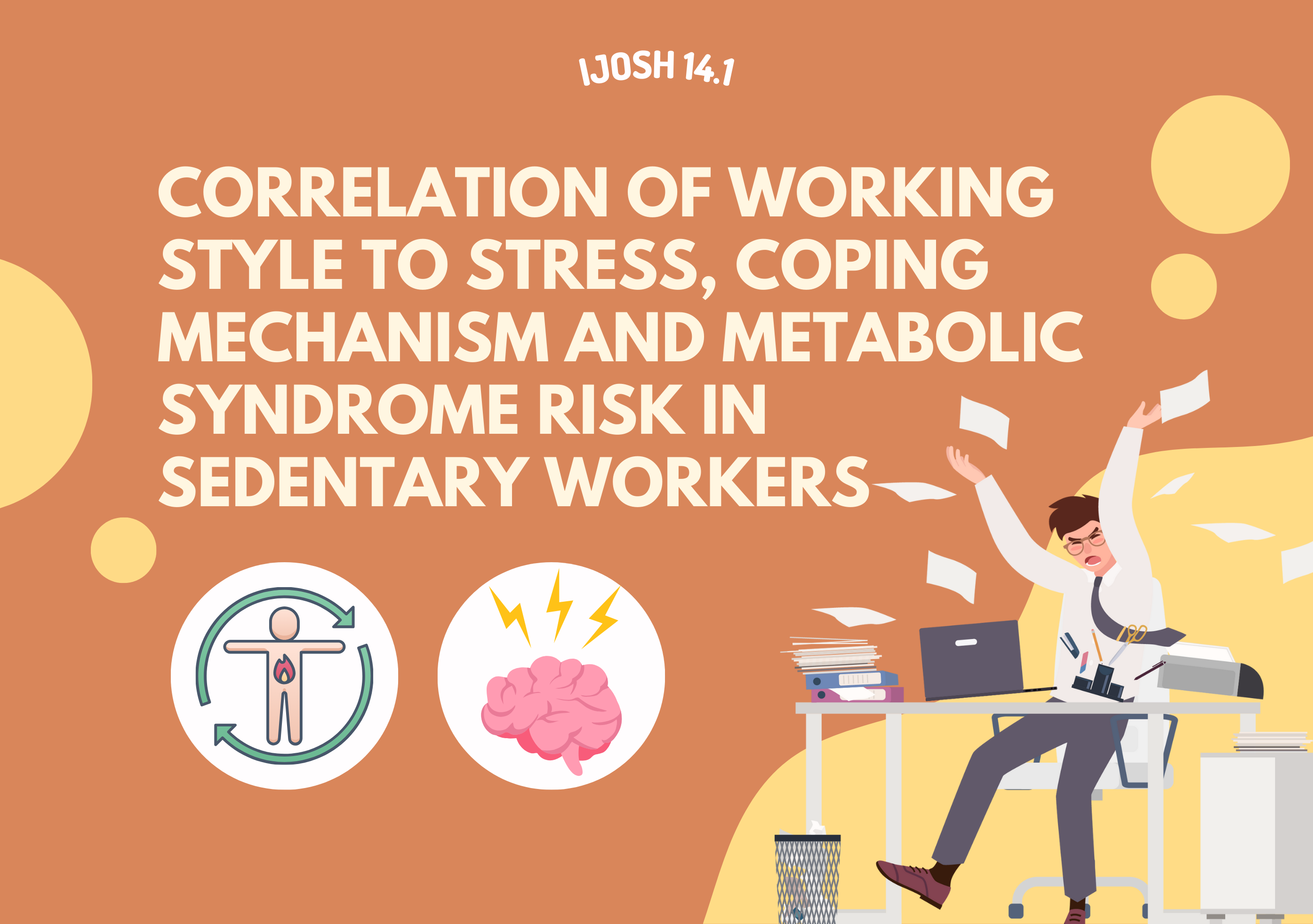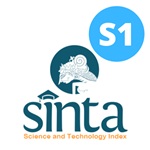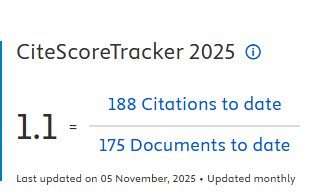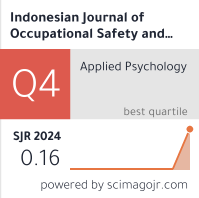Correlation of Working Style to Stress, Coping Mechanism and Metabolic Syndrome Risk in Sedentary Workers

Downloads
Introduction: Emotional eating, as a method of stress coping mechanism in workers, makes a person tend to consume more energy daily. Uncontrolled daily intake will lead to a high probability of a person developing metabolic syndrome in the future. The aim of this study is to analyze the relationship between working style to stress, coping mechanisms, and metabolic syndrome risk in sedentary workers. Method: This research is a cross-sectional study conducted at Kalla Group. Measurement of blood biochemistry (total cholesterol, blood glucose and uric acid) used FORA 6 Plus, blood pressure was measured using Omron digital sphygmomanometer 7130, waist circumference using Seca 201 measuring tape, and height using GEA microtoise. Measurements of body composition used Omron Karada Scan Hbf 375 Body Fat Composition Monitor Bioimpedance Analyzer. Stress was measured using Kessler Psychological Distress Scale K10 instrument. Coping mechanism was measured using Carver’s COPE Inventory. Result: Significant correlations were found for cholesterol levels (p = 0.044), waist circumference (p = 0.036), blood pressure (p = 0.042), and muscular percentage (p = 0.032). No significant correlations were found between working style for stress level (p = 0.683), coping mechanisms (p = 0.744), blood glucose (p = 0.128), uric acid (p = 0.380), visceral fat percentage (p = 0.128), and fat mass (p = 0.547). Conclusion: Significant correlations were found between working style for cholesterol levels, waist circumference, blood pressure, and muscular percentage, suggesting that different working styles may influence these health aspects.
Aly, N.M. et al (2022) ‘Association between COVID-19 Stress, Coping Mechanisms and Stress-related Oral Conditions among Egyptian Adults: A Cross-Sectional Study’, Scientific Reports, 12(1). https://doi.org/10.1038/s41598-022-22961-z
Anestal, C. (2022) Stress, Coping, and Disease Awareness with Metabolic Disease Risk: A Longitudinal Cohort Study. Available at: http://library.ucf.edu
Aras, R.A., Tandiayuk, S. and Fatihah, R.N. (2023) ‘The Relationship Between Stress Coping Strategies and Work-Life Balance Among Bank Employees’, Jurnal Office: Jurnal Pemikiran Ilmiah dan Pendidikan Administrasi Perkantoran, 9(1), pp. 101–108. Available at: http://ojs.unm.ac.id/jo.
Arnett, J.J., Žukauskiene, R. and Sugimura, K. (2014) ‘The New Life Stage of Emerging Adulthood at Ages 18-29 Years: Implications for Mental Health’, The Lancet Psychiatry. Elsevier Ltd, pp. 569–576. https://doi.org/10.1016/S2215-0366(14)00080-7
Balogh, I. et al (2019) ‘Work-related neck and upper limb disorders - Quantitative exposure-response relationships adjusted for personal characteristics and psychosocial conditions’, BMC Musculoskeletal Disorders, 20(1). https://doi.org/10.1186/s12891-019-2491-6
Barnes, T.L. et al (2015) ‘Snacking Behaviors, Diet Quality, and Body Mass Index in a Community Sample of Working Adults’, Journal of the Academy of Nutrition and Dietetics, 115(7), pp. 1117–1123. https://doi.org/10.1016/j.jand.2015.01.009
Bonnet, J.P. et al (2020) ‘Breakfast Skipping, Body Composition, and Cardiometabolic Risk: A Systematic Review and Meta-Analysis of Randomized Trials’, Obesity, 28(6), pp. 1098–1109. https://doi.org/10.1002/oby.22791
Bush, D.E. et al (2014) ‘Evaluation of a pilot promotora program for Latino forest workers in Southern Oregon’, American Journal of Industrial Medicine, 57(7), pp. 788–799. https://doi.org/10.1002/ajim.22347
Christoffersen, T. et al (2023) ‘Development of an Approach for Identifying Overnutrition among Older Adults in Community Health Care Settings: - an Opinion Paper’, Clinical Nutrition Open Science, 47, pp. 102–120. https://doi.org/10.1016/j.nutos.2022.12.008
Ebrahim, O.S. et al (2024) ‘Perceived Stress and Anxiety among Medical Students at Helwan University: A Cross-Sectional Study’, Journal of Public Health Research, 13(1). https://doi.org/10.1177/22799036241227891.
Gennuso, K. et al (2013) ‘Sedentary Behavior, Physical Activity, and Markers of Health in Older Adults’, Medicine and Science in Sports Exercise, 45, pp. 1493–500. https://doi.org/10.1249/MSS.0b013e318288a1e5.Sedentary.
Goetzel, R.Z. et al (2014) ‘Do Workplace Health Promotion (Wellness) Programs Work?’, Journal of Occupational and Environmental Medicine, 56(9), pp. 927–934. https://doi.org/10.1097/JOM.0000000000000276.
Graves, B.S. et al (2021) ‘Gender Differences in Perceived Stress and Coping among College Students’, PLoS ONE, 16(8), pp. 1-12. https://doi.org/10.1371/journal.pone.0255634.
Grundy, S.M. (2016) ‘Metabolic Syndrome Update’, Trends in Cardiovascular Medicine, 26(4), pp. 364–373. https://doi.org/10.1016/j.tcm.2015.10.004.
Health, I.M. of (2015) ‘Infodation : Situasi Kesehatan Kerja’, Pusat Data dan Informasi Kementerian Kesehatan RI [Preprint]. Available at: https://www.kemkes.go.id/download.php?file=download/pusdatin/infodatin/infodatin-kesja.pdf.
Hill, M., Mostafa, S. and Obeng-Gyasi, E. (2024) ‘Chronic Stress Indicator: A Novel Tool for Comprehensive Stress Analysis’, International Journal of Environmental Research and Public Health, 21(3), pp. 1-27. https://doi.org/10.3390/ijerph21030302.
Hosker, D.K., Elkins, R.M. and Potter, M.P. (2019) ‘Promoting Mental Health and Wellness in Youth Through Physical Activity, Nutrition, and Sleep’, Child and Adolescent Psychiatric Clinics of North America, 28(2), pp. 171–193. https://doi.org/10.1016/j.chc.2018.11.010.
Hoveling, L.A. et al (2022) ‘Socioeconomic Differences in Metabolic Syndrome Development: Examining the Mediating Role of Chronic Stress using the Lifelines Cohort Study’, BMC Public Health, 22(1), pp. 1-11. https://doi.org/10.1186/s12889-022-12684-1.
Hoyas, I. and Leon-Sanz, M. (2019) ‘Nutritional Challenges in Metabolic Syndrome’, Journal of Clinical Medicine, 8(9), p. 1301. https://doi.org/10.3390/jcm8091301.
International Labour Organization (2016) Workplace Stress: A Collective Challenge, International Labour Organization.
James, K.A. et al (2023) ‘Understanding the Relationships between Physiological and Psychosocial Stress, Cortisol and Cognition’, Frontiers in Endocrinology, 14, pp. 1-20. https://doi.org/10.3389/fendo.2023.1085950
Khairy, H.A. (2022) ‘Coping Strategies’ Effect on Occupational Stress and its Reflection on Employees’ Turnover Intention in Hotels: The Moderating Role of Social Exchange’, Journal of the Faculty of Tourism and Hotels-University of Sadat City, 6(2), pp. 90-110. https://doi.org/10.21608/mfth.2022.274406.
Kinman, G. (2019) ‘Effort-reward Imbalance in Academic Employees: Examining Different Reward Systems’, International Journal of Stress Management, 26(2), pp. 184–192. https://doi.org/10.1037/str0000128.
Kivimäki, M., Bartolomucci, A. and Kawachi, I. (2023) ‘The Multiple Roles of Life Stress in Metabolic Disorders’, Nature Reviews Endocrinology, 19(1), pp. 10–27. https://doi.org/10.1038/s41574-022-00746-8
Lestari, R.F. (2021) ‘Strategi Coping pada Mahasiswa Ditinjau dari Big Five Personality’, Acta Psychologia, 3(1), pp. 29–37. Available at: http://journal.uny.ac.id/index.php/acta-psychologia.
van der Meij, L. et al (2018) ‘Hair Cortisol and Work Stress: Importance of Workload and Stress Model (JDCS or ERI)’, Psychoneuroendocrinology, 89(July), pp. 78–85. https://doi.org/10.1016/j.psyneuen.2017.12.020
Ministry of Health Republik Indonesia (2018) ‘Riset kesehatan dasar (Riskesdas) 2018’, Jakarta: Badan Penelitian dan Pengembangan Kesehatan Kementrian Kesehatan Republik Indonesia [Preprint].
Moslehpour, M. et al (2019) ‘Organizational Climate and Work Style: The Missing Links for Sustainability of Leadership and Satisfied Employees’, Sustainability (Switzerland), 11(1), pp. 1-17. https://doi.org/10.3390/su11010125.
Niculiţă, Z. (2015) ‘The Relationship Between Work Style and Organizational Climate for Romanian Employees’, Procedia Economics and Finance, 32, pp. 1042–1049. https://doi.org/10.1016/s2212-5671(15)01566-x
Nordander, C. et al (2016) ‘Exposure-response Relationships for Work-related Neck and Shoulder Musculoskeletal Disorders - Analyses of Pooled Uniform Data Sets’, Applied Ergonomics, 55, pp. 70–84. https://doi.org/10.1016/j.apergo.2016.01.010.
Park, J.H. et al (2018) ‘Association between Sedentary Time and Cardiovascular Risk Factors in Korean Adults’, Korean Journal of Family Medicine, 39(1), pp. 29–36. https://doi.org/10.4082/kjfm.2018.39.1.29.
Park, S. (2017) ‘Comparison of Body Composition between Fashion Models and Women in General’, Journal of Exercise Nutrition & Biochemistry, 21(4), pp. 22–26. https://doi.org/10.20463/jenb.2017.22.
Pertiwi, E., Denny, H. and Widjasena, B. (2017) ‘Hubungan Antara Beban Kerja Mental Dengan Stres Kerja Dosen Di Suatu Fakultas’, Jurnal Kesehatan Masyarakat (e-Journal), 5(3), pp. 260-268.
Proia, P. et al (2016) ‘Lactate as a metabolite and a regulator in the central nervous system’, International Journal of Molecular Sciences, 17(9), pp.1-20. https://doi.org/10.3390/ijms17091450.
Rachmawati, Y., Anantanyu, S. and Kusnandar (2019) ‘Emotional Eating, Snacking Behavior and Nutritional Status among Adolescents’, International Journal of Public Health Science, 8(4), pp. 413–418. https://doi.org/10.11591/ijphs.v8i4.20398.
Rahma Listyandini et al (2021) ‘The Dominant Factor of Metabolic Syndrome among Office Workers’, Journal of Health Science and Prevention, 5(1), pp. 40–48. https://doi.org/10.29080/jhsp.v5i1.421.
Rose, D.M. et al (2017) ‘Associations of Fatigue to Work-related Stress, Mental and Physical Health in an Employed Community Sample’, BMC Psychiatry, 17(1), pp. 1–8. https://doi.org/10.1186/s12888-017-1237-y.
Ryan, D. and Heaner, M. (2014) ‘Guidelines (2013) for Managing Overweight and Obesity in Adults’, Obesity, 22(S2), pp. i–xvi. Available at: https://doi.org/10.1002/oby.20818.
Salk, R.H., Hyde, J.S. and Abramson, L.Y. (2017) ‘Gender Differences in Depression in Representative National Samples: Meta-analyses of Diagnoses and Symptoms’, Psychological Bulletin, 143(8), pp. 783–822. https://doi.org/10.1037/bul0000102.
Samudera, W.S., Efendi, F. and Indarwati, R. (2021) ‘Effect of Community and Peer Support based Healthy Lifestyle Program (CP-HELP) on self-care behavior and fasting blood glucose in patient with type 2 Diabetes Mellitus’, Journal of Diabetes and Metabolic Disorders, 20(1), pp. 193–199. https://doi.org/10.1007/s40200-021-00729-y.
Samuel, L. and Cohen, M. (2018) ‘Expressive Suppression and Emotional Eating in Older and Younger Adults: An Exploratory Study’, Archives of Gerontology and Geriatrics, 78, pp. 127–131. https://doi.org/10.1016/j.archger.2018.06.012
Santos, D.A. et al (2014) ‘Reference Values for Body Composition and Anthropometric Measurements in Athletes’, PLoS ONE, 9(5). https://doi.org/10.1371/journal.pone.0097846.
Serin, Y. and Şanlıer, N. (2018) ‘Emotional Eating, the Factors which Affect Food Intake and Basic Approaches of Nursing Care’, Journal of Psychiatric Nursing, 9(2), pp.135-146. https://doi.org/10.14744/phd.2018.23600.
Shchaslyvyi, A.Y., Antonenko, S. V. and Telegeev, G.D. (2024) ‘Comprehensive Review of Chronic Stress Pathways and the Efficacy of Behavioral Stress Reduction Programs (BSRPs) in Managing Diseases’, International Journal of Environmental Research and Public Health. Multidisciplinary Digital Publishing Institute (MDPI), 21(8), pp. 1-55. https://doi.org/10.3390/ijerph21081077.
Shuremu, M., Belachew, T. and Hassen, K. (2023) ‘Nutritional Status and its Associated Factors among Elderly People in Ilu Aba Bor Zone, Southwest Ethiopia: A Community-based Cross-sectional Study’, BMJ Open, 13(1). https://doi.org/10.1136/bmjopen-2022-067787.
Sigit, F.S. et al (2020) ‘The Prevalence of Metabolic Syndrome and its Association with Body Fat Distribution in Middle-aged Individuals from Indonesia and the Netherlands: A Cross-sectional Analysis of Two Population-based Studies’, Diabetology and Metabolic Syndrome, 12(1). https://doi.org/10.1186/s13098-019-0503-1.
Srikanthan, P. et al (2021) ‘Sex Differences in the Association of Body Composition and Cardiovascular Mortality’, Journal of the American Heart Association, 10(5). https://doi.org/10.1161/JAHA.120.017511.
Stammers, L. et al (2020) ‘Identifying stress-related eating in behavioural research: A review’, Hormones and Behavior, 124, pp. 1-13. https://doi.org/10.1016/j.yhbeh.2020.104752.
Tan, C.C. and Chow, C.M. (2014) ‘Stress and Emotional Eating: The Mediating Role of Eating Dysregulation’, Personality and Individual Differences, 66, pp. 1–4. https://doi.org/10.1016/j.paid.2014.02.033.
Theodoratou, M. and Argyrides, M. (2024) ‘Neuropsychological Insights into Coping Strategies: Integrating Theory and Practice in Clinical and Therapeutic Contexts’, Psychiatry International. Multidisciplinary Digital Publishing Institute (MDPI), pp. 53–73. https://doi.org/10.3390/psychiatryint5010005.
Tseng, L.A. et al (2014) ‘Body Composition Explains Sex differential in Physical Performance among Older Adults’, Journals of Gerontology - Series A Biological Sciences and Medical Sciences, 69(1), pp. 93–100. https://doi.org/10.1093/gerona/glt027.
Upadhyay, J. et al (2018) ‘Obesity as a Disease’, Medical Clinics of North America, 102(1), pp. 13–33. https://doi.org/10.1016/j.mcna.2017.08.004.
Wang, B. and Torriani, M. (2020) ‘Artificial Intelligence in the Evaluation of Body Composition’, Seminars in Musculoskeletal Radiology, 24(1), pp. 30–37. https://doi.org/10.1055/s-0039-3400267.
Zahtamal, Z., Prabandari, Y.S. and Setyawati, L. (2014) ‘Prevalensi sindrom metabolik pada pekerja perusahaan’, Kesmas: Jurnal Kesehatan Masyarakat Nasional (National Public Health Journal), 9(2), pp. 113–120.

This work is licensed under a Creative Commons Attribution-NonCommercial-ShareAlike 4.0 International License.

In order to be accepted and published by The Indonesian Journal of Occupational Safety and Health, Author(s) who submit an article should complete all the review process. The copyright of received articles assigned to the The Indonesian Journal of Occupational Safety and Health and Department of Safety and Health, Universitas Airlangga as publishers of the journal. The intended copyright includes the rights to publish articles in various forms (including reprints).
The Editorial Team of The Indonesian Journal Of Occupational Safety and Health and Department of Safety and Health strive to ensure that no errors occur in the articles that have been published, both data errors and statements in the article.
Users of this website will be licensed to use materials from this website following the Creative Commons Attribution-NonCommercial-ShareAlike 4.0 International License. No fees charged. Please use the materials accordingly.
------------------------------------------------------------------------------------------------------------------------------------------------------------------------------------------
Attribution ” You must give appropriate credit, provide a link to the license, and indicate if changes were made. You may do so in any reasonable manner, but not in any way that suggests the licensor endorses you or your use.
NonCommercial ” You may not use the material for commercial purposes.
ShareAlike ” If you remix, transform, or build upon the material, you must distribute your contributions under the same license as the original.







 How to Submit Articles in OJS
How to Submit Articles in OJS

























